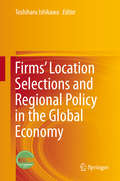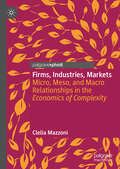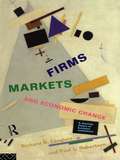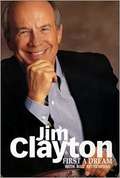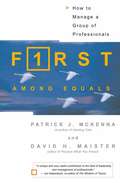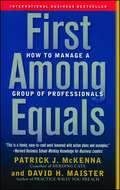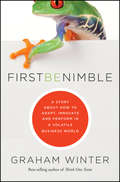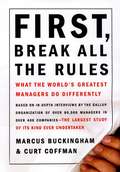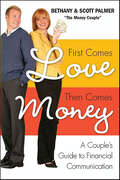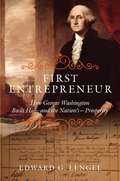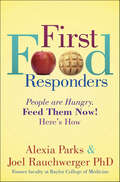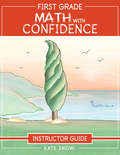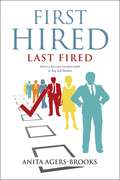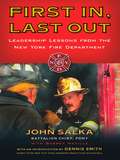- Table View
- List View
Firms' Location Selections and Regional Policy in the Global Economy
by Toshiharu IshikawaThis book offers a new understanding of how firms determine their location and what kinds of regional economic policies are needed to attract factories to a country and a region in a highly globalized economic setting. The theoretical and empirical analyses examine the influence of the transfer pricing system, corporate tax rates, and a country's industrial structure on a firm's decision to locate and the impact of firms' location on regional economic activities. The theoretical analysis elucidates the importance of the above-mentioned factors in the firm's selection of possible location. The empirical analysis uses as an example the case of a supply chain in East Asia. The empirical analysis is illustrated with the regional/spatial development experiences at the country level and city level of selected countries and cities. The analysis offers a perspective for understanding the spatial patterns of a cross-border production system.
Firms, Industries, Markets: Micro, Meso, and Macro Relationships in the Economics of Complexity
by Clelia MazzoniThis book offers a rigorous discussion on how we can understand economic systems through a complexity lens. In particular, the author investigates the relationships between the firms, the industries, and markets (micro, meso, macro relationships), in order to help us better understand the main challenges of a representation of the economy using the “complex systems’ theory”. The author argues that the logic of governance in the paradigm of complex systemic rationality renounces anthropocentric vision of the organization and the possibility of total direction and control over systemic and intersystemic relations and accept a constructivist vision of these relations and their mutual interdependencies. Offering a novel perspective, this book contributes to improve our understanding of economic complex systems and how organizations at different levels interact.
Firms, Markets and Economic Change: A dynamic Theory of Business Institutions
by Richard N. Langlois Paul L. RobertsonTraditonal western forms of corporate organization have been called into question by the success of Japanese keiretsu. Firms, Markets and Economic Change draws on industrial economics, business strategy, and economic history to develop an evolutionary model to show when innovation is best undertaken. The authors argue that innovation is a complex p
Firmwide 360-degree Performance Evaluation Process at Morgan Stanley
by M. Diane BurtonDescribes Morgan Stanley's firmwide, 360-degree performance evaluation process. Evaluation forms are included as exhibits.
First A Dream
by Jim ClaytonOne of the Forbes 400 wealthiest Americans, former CEO Clayton tells his story, from being born to poor cotton farmers in west Tennessee to building Clayton Homes into one of the top distributors and loaners in the mobile home industry.
First American Bank: Credit Default Swaps
by George Chacko Eli Peter StrickThis case examines a bank's ability to manage its credit exposure to a particular client using credit default swaps.
First American Bank: Credit Default Swaps
by George Chacko Eli Peter StrickThis case examines a bank's ability to manage its credit exposure to a particular client using credit default swaps.
First Among Equals: How To Manage A Group Of Professionals
by David H. Maister Patrick J. MckennaManaging people over whom you have no real power is a challenge, particularly in professional service firms where, increasingly, top professionals are being tapped to lead their peers. In this guide, two renowned consultants show professional group managers lacking formal authority how to lead colleagues to peak performance. They speak directly to those who have gone from focusing on their own performance to being a group manager in charge of leading others. From understanding the group leader role to setting terms of reference and effectively dealing with talented prima donnas, McKenna and Maister present a thorough introduction to managing and orchestrating talent.
First Among Equals: How to Manage a Group of Professionals
by David H. Maister Patrick J. McKennaProfessional service gurus David Maister and Patrick McKenna have created a practical handbook on how to lead professional colleagues or peers when you lack formal authority. Harvard Business School’s Working Knowledge calls it “a timely, easy to read work leavened with action plans and examples.”Whether you have recently been appointed as a group leader or are a battle-scarred veteran, you know that managing professional people is difficult! In this unique handbook, Patrick J. McKenna and David H. Maister argue that leaders will best enable their people to achieve peak performance not by managing them, not by leading them, but by inspiring them. The authors show you how to actually add value as a group leader or induce people to accept your guidance, even with intelligent professionals who are often free-agents accustomed to having automony to work on grueling assignments with little supervision. They also give advice on how to handle those oh-so-talented but oh-so-annoying professionals who exhibit attitude problems or are just exceedingly difficult to work with, when you need them but they tend to needle you. The lessons and learning presented here will give you insights and action tips to help you provoke and inspire your people to their full potential.
First Be Nimble
by Graham WinterThe how-to guide to building an adaptive, productive business environmentGraham Winter, author of the best-selling Think One Team, brings you First Be Nimble: A Story about How to Adapt, Innovate and Perform in a Volatile Business World. This book addresses the challenge of how to equip businesses to adapt and thrive in an unpredictable and demanding economy. Told in the form of a fable and illustrated with case studies and powerful tools, the book is designed to engage, inspire, and inform readers from all walks of business life.Helping leaders, teams, and whole organisations to bring their values to the frontline of the battle to be adaptive and productive, First Be Nimble shows readers how to align people and teams, collaborate and co-create with others, reduce resistance to change, boost trust, personal resilience, and performance, and prepare for the unique challenges of adaptive change.Helps businesses adapt to today's environment, learn to innovate, and build a "one team'" mentalityGives leaders the practical tools to facilitate change and foster the conversations that help people to learn and grow togetherUses a unique, fable-style format, with inspirational examples, to bring key concepts to lifeWhile many business leaders are well versed in the importance of company values, they are often ignorant of how to bring them to life, and how to build an adaptive, high performing business. First Be Nimble is here to help.
First Break All the Rules: What the World's Greatest Managers Do Differently
by Marcus Buckingham Curt Coffman"Finally, something definitive about what makes for a great workplace." - Harriet Johnson Brackey, Miami Herald
First Comes Love, Then Comes Money: A Couple's Guide to Financial Communication
by Scott Palmer Bethany PalmerHappy Couples Know How to Talk About MoneyThe number one cause for divorce is financial infidelity. Now "The Money Couple" reveals the missing ingredient needed before any financial program or plan can work: healthy financial communication. This book tells you how to:Diagnose your level of financial infidelityIdentify your individual Money PersonalityMaster the Money Huddle and the Money DumpAchieve financial goals once and for all
First Commonwealth Financial Corp.
by Robert S. KaplanFirst Commonwealth Financial Corp., a financial institution in central and southwestern Pennsylvania, implemented the Balanced Scorecard for describing and implementing its new customer-focused strategy. Its founder and chairman decided that the Balanced Scorecard also should become the primary information input for the corporate governance process with the board of directors so that the board could become more knowledgeable about and more actively involved in the company's strategy. Describes how the board became knowledgeable about the company's Balanced Scorecard and how it participated in developing a Balanced Scorecard for itself. In addition to the enterprise and board scorecards, the company also developed scorecards for each senior executive for the governance and compensation committees to assess and reward senior management performance. Extensive exhibits illustrate the three different scorecards and the reports and supporting documents for these scorecards.
First Community Bank (A)
by Rosabeth Moss KanterFirst Community Bank, a bank-within-a-bank at Bank of Boston, was established in 1990 as a unique venture to serve urban communities. By 1995 it has achieved profitability but must manage relationships with the mainstream at Bank of Boston, serve as a change agent and role model, and face the challenge of reexamining its mission and structure.
First Direct (A)
by Jeffrey F. Rayport Dickson L. LouieDescribes the operations and strategy of the world's largest, fastest growing branchless bank. Using a person-to-person interface over conventional phone lines, First Direct provides standard banking and related financial products to nearly 700,000 customers throughout the United Kingdom. By employing a sophisticated customer information system and a highly educated workforce on the frontline, the bank has achieved customer satisfaction and retention levels that are roughly twice those of its nearest competitor in either direct or traditional retail banking services. This outcome was achieved through the use of information infrastructure to personalize services, model preference profiles, and cross-sell relevant products in the course of over-the-phone banking interactions. This breakthrough service model has demonstrated that banks may deliver greater quality of service at significantly lower costs by exploiting virtual or "marketspace" channels for service delivery and customer relationship management. The question facing the bank, a unit of Midland plc (which was, in turn, owned by HSBC), was how fast, in what manner, and in what market segments the organization should grow.
First Draft: Getting It Down
by Harvard Business Review PressAn effective writer always begins with a first draft in which ideas can be collected and organized. Once the ideas are down on paper, details like punctuation, grammar, and word choice are often far less painful to perfect. This chapter explains the benefit of a first draft and focuses on three tools that writers should consider as they develop the draft.
First Entrepreneur: How George Washington Built His--and The Nation's--prosperity
by Edward LengelGeorge Washington was not only "first in war, first in peace, and first in the hearts of his countrymen"--he was also America's most important entrepreneur.
First Federal Savings (A)
by Jay W. Lorsch Stephen X. DoyleRaises questions about basing a reward system on profit and changing MBO indicators through time.
First Food Responders: People are Hungry. Feed Them Now! Here’s How
by Alexia ParksFirst Food Responders™ teaches an innovative new way to manage food security, home security and job creation. Formed from the First Food Responder program, this book is for the person who loves to cook, has a home kitchen and who is looking for a home-based job that comes with a sense of passion, purpose, and dignity.As a First Food Responder, these trained, licensed home cooks can be part of a diversified network of home cooks who are able to respond “on demand” to an emergency in their own community. They are feeding vulnerable populations including some of America’s estimated 60 million hungry families and their children. Their job includes learning safety protocols required to run a small business from their own home kitchen or a commercial kitchen.The path to Zero Hunger for America and the world starts in the kitchen of a First Food Responder. With a mission of helping people eat better food they are also helping improve public health, food security and community resiliency.When delicious, home-cooked food is made with love by neighbors who care, First Food Responders are creating change through food, one meal at a time.
First Grade Math with Confidence Instructor Guide (Math with Confidence #5)
by Kate SnowEasy-to-use, comprehensive coverage of all essential first grade math topics. This scripted, open-and-go program from math educator Kate Snow will give you the tools you need to teach math with confidence—even if you’ve never taught math before. Short, engaging, and hands-on lessons will help your child develop a strong understanding of math, step by step. Counting, comparing, and writing numbers to 100 Addition and subtraction facts to 20 Addition and subtraction word problems Beginning place-value and mental math Shapes, money, time, and measurement
First Hired, Last Fired: How to Become Irreplaceable in Any Job Market
by Anita Agers-BrooksUnemployment is a daunting concern for people all across the nation. Layoffs and corporate downsizing threatens jobs now more than ever. FIRST HIRED, LAST FIRED shows how to discover simple secrets from an ancient text that can make anyone irreplaceable.Today's employees face terror and stress at the prospect of losing their jobs, and finding new ones. The global climate reeks of confusion, fear, anxiety, and competition while people clamber for jobs. Layoffs and shrinking markets choke confidence from qualified workers.FIRST HIRED, LAST FIRED shows readers how to use the valuable wisdom found in the ancient text of the Bible to avoid becoming disposable in this challenging marketplace. Through timeless wisdom, simple solutions, and easy-to-apply principles, readers will find meaning in their work lives, and deep satisfaction from committing to a job well done. Through practice, the reader will learn to look deeper into the Bible for relevant help with current issues.
First In, Last Out
by John Salka Barret NevilleWhat does it take to lead people into a burning building? How do the leaders of the New York City Fire Department develop so much loyalty, trust, and grace under pressure that their subordinates will risk their very lives for them?As a high-ranking officer of the FDNY, John Salka is an expert at both practicing and teaching high-stakes leadership. In First In, Last Out, he explains the department's unique strategies and how they can be adopted by leaders in any field-as he has taught them to organizations around the country. In a tough-talking, no-nonsense style, Salka uses real-world stories to convey leadership imperatives such as: first in, last out-your people need to see you taking the biggest risk, as the first one to enter the danger zone and the last to leave manage change-the fire you fought yesterday is not the one you'll be fighting tomorrow communicate aggressively-a working radio is worth more than 20,000 gallons of water create an execution culture-focus your people on the flames, not the smoke commit to reality-never allow the way you would like things to be to color how things are develop your people-let them feel a little heat today or they'll get burned tomorrow Illustrated by harrowing real-life situations, the principles in First In, Last Outwill help managers become more confident, coherent, and commanding.
First Investments, Inc.: Analysis of Financial Statements
by David F. HawkinsA summer intern is asked to perform a financial value analysis of a company's financial report for the period 1987-1994.
First National Bank Corp. (A)
by Charles A. Nichols Mary E. BarthFirst National Bank Corp., a major regional bank in the Northeast, must decide how large a provision for credit losses to accrue in its 1990 financial statements. The recession in New England has caused serious problems in its loan portfolio.
